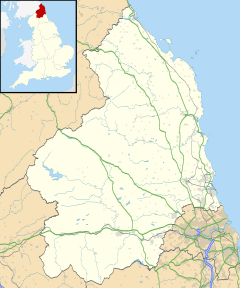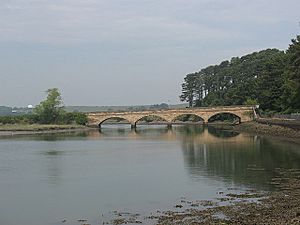Alnmouth facts for kids
Quick facts for kids Alnmouth |
|
|---|---|
 View of Alnmouth and the estuary of the River Aln |
|
| Population | 445 |
| OS grid reference | NU245105 |
| Unitary authority |
|
| Ceremonial county | |
| Region | |
| Country | England |
| Sovereign state | United Kingdom |
| Post town | ALNWICK |
| Postcode district | NE66 |
| Dialling code | 01665 |
| Police | Northumbria |
| Fire | Northumberland |
| Ambulance | North East |
| EU Parliament | North East England |
| UK Parliament |
|
Alnmouth is a pretty village on the coast of Northumberland, England. It's about 4 miles (6.4 km) east-south-east of Alnwick. In 2011, about 445 people lived here.
Alnmouth is located where the River Aln meets the sea. Long ago, it was a busy port with a small fishing industry. It also traded goods with other parts of England and even other countries! Alnmouth was a top place for sending out grain and food, especially to London. It also brought in wood and slate. This trade shaped the village, as big storage buildings for grain were built. There were also sawmills and a place to build boats.
However, port activities slowed down by the late 1800s. This happened because the river mouth changed and filled with sand. Also, trade started moving to the railways instead of ships. A huge storm in 1806 even changed the river's path! This damaged the old church and made it harder for the port to work.
When the railways arrived, Alnmouth changed into a popular holiday spot. It got one of England's first golf courses, a holiday camp, and special houses for bathing. Today, Alnmouth is a well-kept, beautiful coastal village. It's a popular place for tourists and is part of the amazing Northumberland Coast National Landscape.
Contents
Alnmouth: A Coastal Village with History
How Alnmouth Grew Over Time
From Ancient Times to a Busy Port
Alnmouth was officially started as a village by William de Vesci in 1152. He was given permission to set up a court and a settlement on a piece of land near the river. Later, in 1207 or 1208, Eustace de Vesci got royal permission to create a port and a fish market.
Before the village was officially founded, people likely used this area for a very long time. Coastal areas were some of the first places where humans settled in Britain. Some old flint tools from the Middle Stone Age have been found here. There are also signs of the Bronze Age, like ancient burial sites and a spearhead. Some believe an old enclosure in the north of the village might be from the Iron Age.
Even though no Roman ruins have been found, it's thought the Romans knew about and used the river mouth. An ancient writer named Ptolemy mentioned a river called Alaunus. The harbour would have been useful for Roman armies and for trading.
The Port's Rise and Fall
Alnmouth's port has a long history of fishing and trade, going back 800 years. The village faced tough times, like attacks by the Scots in 1336. The terrible Black Death in 1348 also caused many problems. In 1597, the village was described as "depeopled," meaning many people had left. By 1614, it was still in "great ruin." However, a survey in 1567 showed that 20 out of 60 homes in Alnmouth were involved in fishing.
Things seemed to get better in the 1600s and 1700s, and trade at the port grew a lot. The most important thing shipped out from Alnmouth was grain. A big import was guano from Peru, which was used to help farms grow more food. Other things shipped out included coal, eggs, pork, and fish for London. Wool was sent to Yorkshire for making clothes. Imports included blue slate from Scotland and wood from Holland and Scandinavia. Because of the grain trade, there were 16 large grain storage buildings in the village. Some of these were later turned into homes.
The port was also a place for building ships, though on a smaller scale. Around 1750, up to 18 ships could be seen in the harbour at one time.
During the American War of Independence in 1779, an American ship captain named John Paul Jones attacked the port. He even fired his cannons at the church!
A big change happened on Christmas Day in 1806. A strong storm caused the river to change its path. Instead of winding around, it took a more direct route to the sea. This change is sometimes blamed for the port's decline. By the end of the 1800s, traffic at the port had almost completely stopped.
In 1852, a special model lifeboat was brought to Alnmouth. It was later given to the Royal National Lifeboat Institution in 1854. A new boathouse was built in 1860, but the Alnmouth Lifeboat Station closed in 1935.
Becoming a Popular Holiday Spot
As the port declined, Alnmouth found a new purpose: a holiday and second-home resort. When the railway arrived nearby in 1847, the village changed. Large houses with sea views were built. Old grain buildings were turned into homes or taken down to make way for new cottages. Maps from 1897 show a holiday camp, a garden tea-room, and many beach huts among the sand dunes. There were even heated baths near the village's gas station. A golf course was built in 1869, making it one of the oldest in England.
During World War II, people worried about invasion. Different defenses were built on Alnmouth's beaches. These included concrete blocks to stop tanks, ditches, and small concrete shelters called pill-boxes. The old gun battery from the 1800s was also made stronger. You can still see parts of these defenses today.
In 2020, Condé Nast Traveler magazine named Alnmouth one of the "20 most beautiful villages in the UK and Ireland." They suggested visiting Alnwick Castle nearby. The Northumberland Guide also says the village is "well worth exploring" with its "colourful cottages."
Exploring Alnmouth's Location
Where is Alnmouth?
Alnmouth is on the north-east coast of England. It's about 29 miles (47 km) north of Newcastle upon Tyne and 4.1 miles (6.6 km) east-south-east of Alnwick. The village is built on a piece of land with the North Sea to the east and the River Aln estuary to the south and west. The land slopes from about 17.2 meters (56 ft) above sea level in the north to 3.5 meters (11 ft) in the south-west.
The land around Alnmouth has a layer of clay left by glaciers. Underneath that is limestone, and near the coast, there's sand blown by the wind, forming sand dunes. The coastline has many headlands and sandy beaches. Alnmouth's south beach dunes are made mostly of sea animal shells and are only 200-300 years old.
Nature and Protected Areas
Alnmouth's coastline has several special protected areas. It's at the southern end of the Northumberland Coast National Landscape, which is an Area of Outstanding Natural Beauty. This means the area's natural beauty is protected. The salt flats in the river mouth and the south beach dunes are a Site of Special Scientific Interest. This is because they have many different types of plants. In 2006, some flood banks were broken to let the tide come in. This helped create new salt flats for wading birds and also helped prevent flooding. The golf course area, north of the village, is registered as common land.
Most of the village was made a conservation area in 1972. This helps protect its historic buildings. The village has a mix of buildings from the 1600s, 1700s, and 1800s. These include small cottages and large Victorian houses. Many of them are "Grade II listed," meaning they are important historic buildings.
Getting Around Alnmouth
Alnmouth has its own Alnmouth railway station, which is actually in Hipsburn, about a mile (1.6 km) inland. It's also on the X18 bus route, which connects Berwick, Alnwick, Amble, and Newcastle.
Two roads lead into the village. The B1336 goes from the north of Alnmouth to Hipsburn. This road connects to the A1068, which goes between Alnwick and Ashington. This connection was improved in 1856 when the Duchess's Bridge was built over the River Aln. This bridge made it easier to get to the new railway station.
Before the bridge was built, people crossed the river at two shallow spots called fords. One ford led towards Hipsburn and Alnwick, and another led towards Warkworth. There were also stepping-stones that could be used at low tide.
The village is also part of National Cycle Route 1, which is a long-distance cycling path.
Famous People from Alnmouth
- Arthur Campbell Walker helped start the Alnmouth Golf Club.
- Val McDermid, a famous crime writer, lived in Alnmouth for a while.



